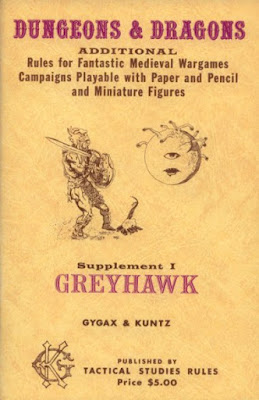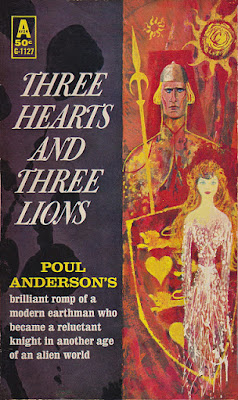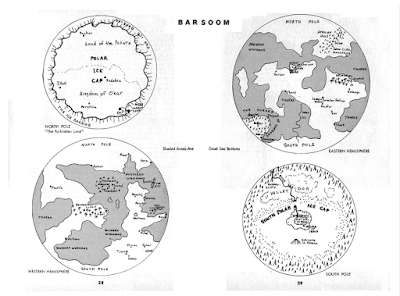Alignment Table, from Supplement I: Greyhawk
Note that non-intelligent creatures, such as carrion crawlers and gelatinous cubes, are not included.
Attacks and variable damage were provided for the monsters described in OD&D vol. 2 "Monsters & Treasure" as well as new monsters described in the Greyhawk supplement, in addition to creatures mentioned in OD&D without entries:
Crocodile, Giant Beetle, Giant Crab, Giant Lizard, Giant (Sumatran) Rat, Giant Scorpion, Giant Snake, Giant Spider, Giant Toad, Giant Weasel, Horse (Light, Medium, Heavy), Lion, Mastodon, Sabre-tooth Tiger, Sea Monster, Tyrannosaurus Rex, Wolf (Normal, Dire)
An alphabetic listing of the new monsters in the Greyhawk supplement, and their probable or confirmed origins, is given, below:
Monsters:
Beholders: Originally conceived by Terry Kuntz, according to the preface in the AD&D 1e Monster Manual by Gary Gygax, and as discussed in this thread on OD&D Discussion.
Blink Dogs: Lawful creatures, the natural enemies of Displacer Beasts.
Bugbears: Described as monsters "of the 'giant class,' being great, hairy goblin-giants". The illustration by Greg Bell in the Greyhawk supplement depicting bugbears with pumpkin-heads was based on a misunderstanding, as Gygax reported in this thread on Dragonsfoot:
Carrion Crawlers: Envisioned as competitors of "ochre jellies, black (or gray) puddings, and the like", one of Gary's contributions to "the clean-up crew".
Displacer Beasts: Inspired by the coeurl, a feline-like creature from the 1939 science fiction story "Black Destroyer" by A. E. van Vogt, later incorporated into the novel The Voyage of the Space Beagle (1950).
Dopplegangers: Based on the Doppelganger of folklore (possibly inspired by an episode of Kolchak: The Night Stalker, involving a doppelganger?)
Dragons: The metallic/"Oriental" types are introduced, including Brass, Copper, Bronze, Silver; Platinum/Dragon King (named as Bahamut in the AD&D 1e Monster Manual); Chromatic/Dragon Queen (named as Tiamat in the AD&D 1e Monster Manual).
Druids: "Priests of a neutral-type religion" who "are combination cleric/magic-users" although the druid character class in Supplement III: Eldritch Wizardry would supersede this version.
Elementals: Additional details are given for elementals, first described in OD&D vol. 2.
Gelatinous Cubes: Originally mentioned in OD&D vol. 2 Monsters & Treasure but only given statistics in the Greyhawk supplement.
Giant Slugs: Conan battles a giant slug in "The Hall of the Dead" by Robert E. Howard and L. Sprague de Camp, 1967
Giant Tick
Golems (Flesh, Stone, Iron): The flesh golem is based on Frankenstein's monster.
Harpies: From the Harpy of Greek mythology.
Hell Hounds: Featured in the short story "In the Bag" by J. Eric Holmes, published in Dragon #58 (Feb 1982)
Homunculus: Created through a special formula involving both an Alchemist and a Magic-User, becoming the servant and counterpart of the latter.
Lammasu: From the Lamassu of Sumerian mythology.
Liches: Modeled after the lich Afgorkon in the short story "The Sword of the Sorcerer" by Gardner Fox, in "Kothar: Barbarian Swordsman" (1969)
Lizard Men: Possibly inspired by the Horibs of Pellucidar (in "Tarzan at the Earth's Core" by Edgar Rice Burroughs, 1929)
Lycanthrope: Wererat/Rat Man (possibly inspired by the rats in "The Swords of Lankhmar" by Fritz Leiber, 1968), discussed here.
Ogre Magi: Oni, or "Japanese Ogres", inspired by General Raiko and the Ogres of O-E-Yama, a beautifully illustrated children's book translated into English from Japanese, according to Gygax.
Owl Bears: Inspired by one of the plastic toy "prehistoric animals" manufactured in Hong Kong.
Phase Spiders: Creatures able to phase into and out of etherealness.
Rust Monsters: Another creature inspired by one of the plastic toy "prehistoric animals" manufactured in Hong Kong.
Salamanders: Originally described as a type of free-willed, fire elemental.
Shadows: These incorporeal creatures feature in "The Sorcerer's Jewel", a short story by J. Eric Holmes, published in Dragon #46 (Feb 1981)
Stirges: Possibly inspired by the Strix of Greek mythology.
Storm Giants
Titans: Based on the Titans of Greek mythology.
Tritons: "Similar to mermen" although tougher and able to use magic-user spells.
Umber Hulks: Able to burrow through solid rock.
Will O' Wisps: Based on the will o' the wisp of folklore.
Vampires: Additional details are given for vampires, including the mention of a variant. "Vampires from the region of the Middle East are invisible, but they are not able to Charm."
Treasure:
The Greyhawk supplement also expanded the magic item tables, including five subtables of miscellaneous magic.
Monsters:
Beholders: Originally conceived by Terry Kuntz, according to the preface in the AD&D 1e Monster Manual by Gary Gygax, and as discussed in this thread on OD&D Discussion.
Blink Dogs: Lawful creatures, the natural enemies of Displacer Beasts.
Bugbears: Described as monsters "of the 'giant class,' being great, hairy goblin-giants". The illustration by Greg Bell in the Greyhawk supplement depicting bugbears with pumpkin-heads was based on a misunderstanding, as Gygax reported in this thread on Dragonsfoot:
The pumpkin-headed bugbear was an artist taking literally my description of the monster as having a head like a pumpkin, i.e large, round flat oval.
Gary Gygax on Dragonsfoot, (Jun 2006)
Carrion Crawlers: Envisioned as competitors of "ochre jellies, black (or gray) puddings, and the like", one of Gary's contributions to "the clean-up crew".
Illustration of a carrion crawler, from the Greyhawk supplement, attributed to Dave Arneson
Displacer Beasts: Inspired by the coeurl, a feline-like creature from the 1939 science fiction story "Black Destroyer" by A. E. van Vogt, later incorporated into the novel The Voyage of the Space Beagle (1950).
Dopplegangers: Based on the Doppelganger of folklore (possibly inspired by an episode of Kolchak: The Night Stalker, involving a doppelganger?)
Dragons: The metallic/"Oriental" types are introduced, including Brass, Copper, Bronze, Silver; Platinum/Dragon King (named as Bahamut in the AD&D 1e Monster Manual); Chromatic/Dragon Queen (named as Tiamat in the AD&D 1e Monster Manual).
Druids: "Priests of a neutral-type religion" who "are combination cleric/magic-users" although the druid character class in Supplement III: Eldritch Wizardry would supersede this version.
Elementals: Additional details are given for elementals, first described in OD&D vol. 2.
Gelatinous Cubes: Originally mentioned in OD&D vol. 2 Monsters & Treasure but only given statistics in the Greyhawk supplement.
Giant Slugs: Conan battles a giant slug in "The Hall of the Dead" by Robert E. Howard and L. Sprague de Camp, 1967
Giant Tick
Golems (Flesh, Stone, Iron): The flesh golem is based on Frankenstein's monster.
Harpies: From the Harpy of Greek mythology.
Illustration from Monster & Treasure Assortment (1980), reprinted from Monster & Treasure Assortment: Set Three (1978), probably by Dave Trampier
Hell Hounds: Featured in the short story "In the Bag" by J. Eric Holmes, published in Dragon #58 (Feb 1982)
Homunculus: Created through a special formula involving both an Alchemist and a Magic-User, becoming the servant and counterpart of the latter.
Lammasu: From the Lamassu of Sumerian mythology.
Liches: Modeled after the lich Afgorkon in the short story "The Sword of the Sorcerer" by Gardner Fox, in "Kothar: Barbarian Swordsman" (1969)
Lizard Men: Possibly inspired by the Horibs of Pellucidar (in "Tarzan at the Earth's Core" by Edgar Rice Burroughs, 1929)
Lycanthrope: Wererat/Rat Man (possibly inspired by the rats in "The Swords of Lankhmar" by Fritz Leiber, 1968), discussed here.
Ogre Magi: Oni, or "Japanese Ogres", inspired by General Raiko and the Ogres of O-E-Yama, a beautifully illustrated children's book translated into English from Japanese, according to Gygax.
Illustration from Monster & Treasure Assortment (1980), reprinted from Monster & Treasure Assortment: Set Two (1977), by David Sutherland
Owl Bears: Inspired by one of the plastic toy "prehistoric animals" manufactured in Hong Kong.
Phase Spiders: Creatures able to phase into and out of etherealness.
Rust Monsters: Another creature inspired by one of the plastic toy "prehistoric animals" manufactured in Hong Kong.
Salamanders: Originally described as a type of free-willed, fire elemental.
Shadows: These incorporeal creatures feature in "The Sorcerer's Jewel", a short story by J. Eric Holmes, published in Dragon #46 (Feb 1981)
Stirges: Possibly inspired by the Strix of Greek mythology.
Attack of the Stirges, from The Strategic Review, vol I, no 5 (Dec 1975), illustration by David Sutherland
Storm Giants
Titans: Based on the Titans of Greek mythology.
Tritons: "Similar to mermen" although tougher and able to use magic-user spells.
Umber Hulks: Able to burrow through solid rock.
Illustration of an umber hulk, from the Blackmoor supplement (1975), by David Sutherland
Will O' Wisps: Based on the will o' the wisp of folklore.
Vampires: Additional details are given for vampires, including the mention of a variant. "Vampires from the region of the Middle East are invisible, but they are not able to Charm."
Treasure:
The Greyhawk supplement also expanded the magic item tables, including five subtables of miscellaneous magic.














































